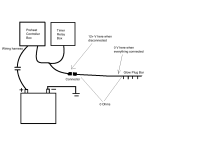k0ua
Epic Contributor
Well it is too late now, but I would have ohmed the glow plugs with the rail off. They should be a little under 1 ohm , but not shorted. a little less than 1 ohm at 12.6 volt would draw a little over 12 amps so about 150 watts per plug. Now you say with the bar off you measure 12.6 volts on the bar, but with it connected you measure near 0 volts. So if none of the glow plugs are a dead short, and if they were, there should be a fuse blowing somewhere. So the only other explanation for the 0 volts on the rail when connected is there is a high resistance connection somewhere in the supply path to the plugs. Perhaps the relay contacts are burnt, or a high resistance connection to them. There is no question in my mind that this is your problem, you just have to find the high resistance that is causing the very low current flow and the extreme drop in voltage. When they get the piece of the glow plug out and the head back on and a new plug put in then they can start to troublshoot the problem again..because it will still be there. Your measurement of 0 volts on the rail when on and 12.6 volts when it is disconnected from the plugs tell the tale. E=IR Ohms law, is not just a good idea it is the law Think of your problem using this simple example.. Take a 12 volt battery and a taillight and hook them together. The tail light lights to full brilliance. Lets say for ease of calculation that the lamp pulls 1 amp of current and since P=EI the E(electromotive force, commonly called Volts) is 12 and we said the I (current measured in Amperes or amps) is 1 amp the wattage for the lamp is 12 Watts and the resistance of the bulb is about 12 ohms. Now put a 10000 ohm resistor in series with the 12 ohm lamp. Will the lamp light to full brilliance? No it will not, the resistor will limit the current to about .001 amps and the voltage will drop on the terminals of the lamp to near 0 . But if you remove the load (the lamp) and measure the battery voltage thru the 10,000 ohm resistor you will measure 12 volts. It is only when you put a load on this voltage path that the voltage will drop and the current will be very low and the power dissipated in the load will be very low. If you will take your meter and measure backward from the glowplug rail with 0 volts until you encounter 12 volts again you can isolate the component or wiring or connection that has the high resistance and is causing the voltage drop and current limiting.
Think of your problem using this simple example.. Take a 12 volt battery and a taillight and hook them together. The tail light lights to full brilliance. Lets say for ease of calculation that the lamp pulls 1 amp of current and since P=EI the E(electromotive force, commonly called Volts) is 12 and we said the I (current measured in Amperes or amps) is 1 amp the wattage for the lamp is 12 Watts and the resistance of the bulb is about 12 ohms. Now put a 10000 ohm resistor in series with the 12 ohm lamp. Will the lamp light to full brilliance? No it will not, the resistor will limit the current to about .001 amps and the voltage will drop on the terminals of the lamp to near 0 . But if you remove the load (the lamp) and measure the battery voltage thru the 10,000 ohm resistor you will measure 12 volts. It is only when you put a load on this voltage path that the voltage will drop and the current will be very low and the power dissipated in the load will be very low. If you will take your meter and measure backward from the glowplug rail with 0 volts until you encounter 12 volts again you can isolate the component or wiring or connection that has the high resistance and is causing the voltage drop and current limiting.
James K0UA
James K0UA
